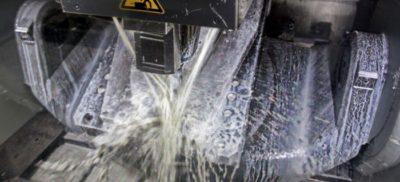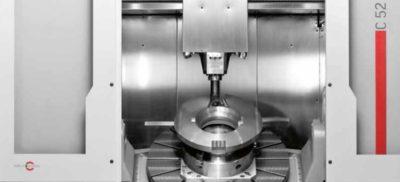Get in touch
If you have any questions about our machines, or interest in setting up a new machining process. Our expert team are more than happy to help.
Home » Mill/ Turn
The latest generation of mill/turn machines from Europe blurs the boundaries between traditional lathes and machining centres.
A mill turn, or multitasking machine, commonly refers to a machine that is capable of both milling and turning operations that can include the use of live tooling. A typical mill turn configuration has multiple axes which, as a minimum include an x, y and c-axis. These allow for milling operations along the length of the part as well as traditional OD and ID lathe turning operations.
The axes that characterise mill turn machines are described in detail below:
A mill turn has a turret tooling setup which allows for the inclusion of both stationary tools as well as live tools for milling operations. This is the key way in which a traditional lathe differs from a mill turn machine.
More advanced machines can have a sub spindle, multiple tool turrets and a separate milling head with a b-axis that lets the tool rotate in relation to the axis of the stock. These advanced mill turn machines can approach the efficiency of automatic turning lathes.
A mill turn is ideal for a job shop that wants to improve manufacturing efficiency. Listed below are some of the key advantages of a mill turn machine:
One set-up – mill turn machines allow for single set-up operations. Instead of first doing operations on the lathe then setting up the part on the mill, mill turns can do the work of both machines with only one set-up. Resulting in ‘done-in-one’ parts.
Tooling – mill turn tools can have multiple turret tool posts with indexed tools. This allows for all the tools required for a job to be setup in advance allowing the machine to run uninterrupted until the part is done. Some machines also have automatic tool changers which further expand the tool inventory.
Consistency – Parts machined in one setup can achieve a higher level of accuracy when compared to parts that are moved between machines, every time a part is moved to a new machine, another variable is added to the equation that increases the likelihood of errors on the final part. A mill turn effectively eliminates human error due to part handling and set-up.
A mill turn is ideal for parts that would require both milling and turning machines, for example if a part requires flat features along its length or if holes are required in the side of a cylindrical part. A mill turn is ideal for parts where the milling required on the part is less than 25%. The machines allow for unmatched speed and efficiency for these types of parts. If you run a job shop then a mill turn is a must have, as it drastically increases the range of parts that can be machined in one operation. Kingsbury offer top of the line mill turn machines that provide unmatched functionality and efficiency.
“The uprated-specification G200 has resulted in reductions in cycle times of up to 28 per cent. It is a direct result of the faster machine movements and more powerful control, as exactly the same programs are being used as on the older machine.”
– Ian Keeley, Senior Manufacturing Engineer
In the mid 1990s, Chas A Blatchford & Sons bought an INDEX G200 turn-mill centre, having decided it was the best machine for manufacturing metal components used in prosthetics for lower limbs. A recent reappraisal of machines on the market showed that the German machine tool builder’s technology is still the best production solution, 15 years on.

Hermle twin-pallet machining centre from Kingsbury chosen for finishin...

A flexible manufacturing system (FMS) for producing small to medium-si...
Triple-turret, twin-spindle turning centre enables one-hit machining,...
If you have any questions about our machines, or interest in setting up a new machining process. Our expert team are more than happy to help.